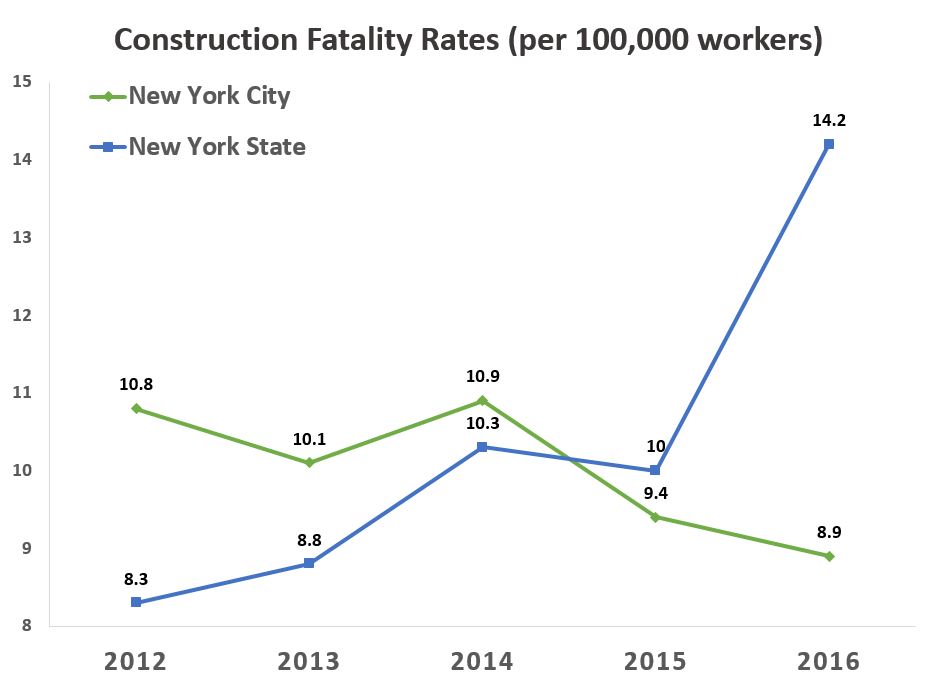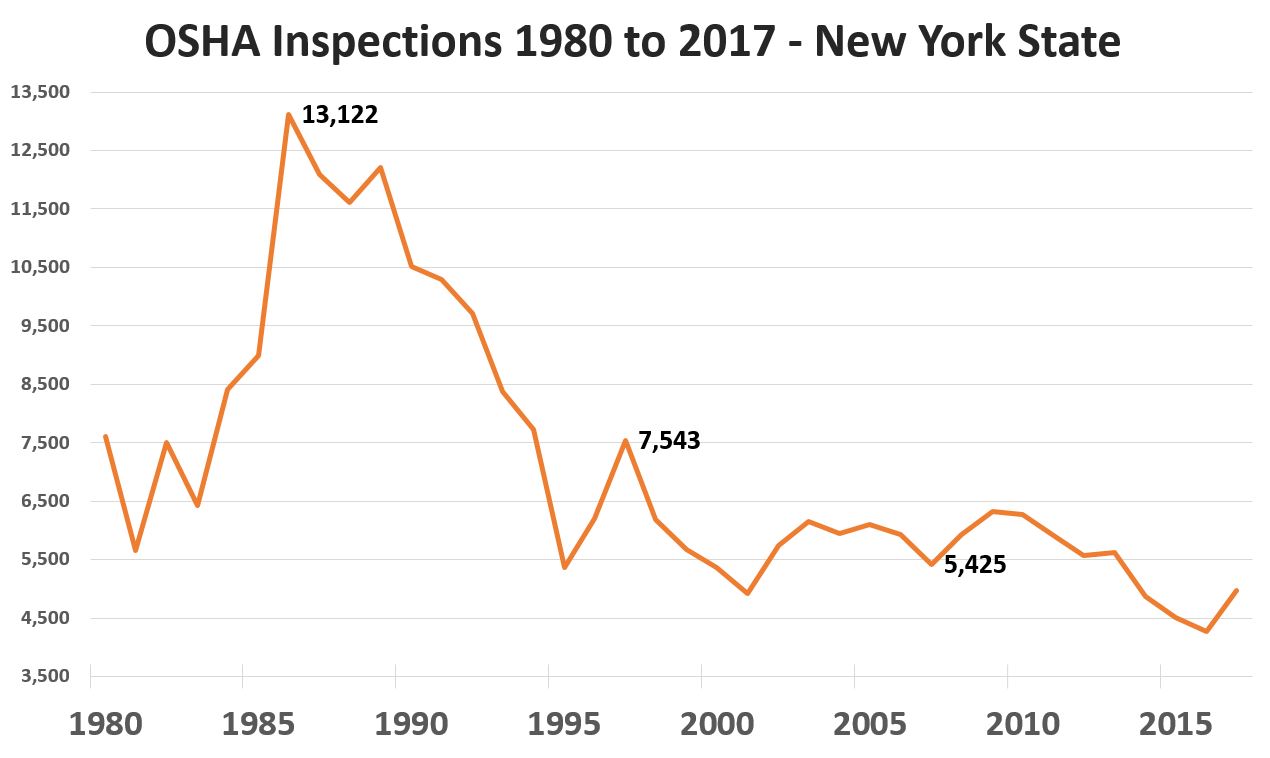Alarmingly, the construction fatality rate in New York State skyrocketed in 2016, according to the latest Deadly Skyline report by New York Committee for Occupational Safety & Health (NYCOSH). 71 construction workers were killed in New York State in 2016 alone – a staggering number that the state hasn’t seen since 2002. According to NYCOSH, there was a steep increase in the fatality rate far beyond the increase in labor, creating an “epidemic of construction fatalities.”
In the past five years, the occupational death rate in construction increased by 29.5% in New York State. By contrast, New York City saw a 21.3% decrease in worker fatalities during that same period. In light of this report, the most pressing question that arises is: why? Why is the construction fatality rate in New York State 60% higher than in New York City? And additionally – what can be done about it?

While New York State is the thirteenth safest state in occupational fatalities, its construction fatality rate has placed it in the top 10 most dangerous states for construction workers – a concerning statistic that highlights the urgency for changes. The NYCOSH report takes a closer look at the reasons below:
1) OSHA is severely underfunded
Federal policies and funding cuts have prevented the Occupational Safety and Health Administration (OSHA) from meeting its core mission of ensuring workplace safety. OSHA’s budget has remained stagnant since 2010, despite the construction boom in states like New York. From 2010 to 2015, funding decreased from $558.8 million in 2010 to $552.79 million in 2015. Additionally, hiring freezes across the nation meant that OSHA cannot replace enforcement staff when employees leave. In just the past year, OSHA has seen a 4% decrease in enforcement staff. Currently, there are fewer than 1,000 inspectors in the country to examine work sites.
As a result of the underfunding, there was a 62.6% cut in the total number of inspections conducted by OSHA in New York State from its high in 1986 (13,122 inspections) to 2017 (4,970 inspections). Yet, New York has experienced a construction boom in the past decade. In New York City alone, there was a 93.5% increase in building construction permits and a 44.7% increase in the labor force from 2000 to 2016 (source: NYC Construction Dashboard). 2016, 2017, and 2018 will rank as the three highest years in construction spending in New York City. The dramatic decrease in safety inspections amidst New York’s building boom has had catastrophic consequences, as evidenced by the deaths of 444 workers killed in construction-related accidents in New York State in the past ten years.
According to NYCOSH, studies have shown that work hazards decrease after an OSHA inspection. Fewer inspections in New York State signifies decreased protection for construction workers. With funding cuts, OSHA now provides one inspector for every 76,402 workers, well below the benchmark set by the International Labor Organization for industrialized countries of one inspector to every 10,000 laborers.

The underfunding of OSHA has also led to significantly fewer press releases on violators. In the past, when employers saw that other companies were getting negative media attention for mistreating their employees, it spurred changes in their organizations. However, with less media attention focused on egregious violators, companies have less incentive to ensure on-the-job safety.
In New York City, the Department of Buildings has played a crucial role in implementing laws that promote job safety. Additionally, the DOB has nearly doubled their inspections at the same time that OSHA has seen a dramatic decrease. Workers outside of NYC do not have an equivalent of New York City’s Buildings Department to protect them. With OSHA seeing even less funding going forward, New York State must act now to implement necessary measures that protect workers.
2) Additional legislation and enforcement needed
Brooklyn District Attorney Eric Gonzalez and other prosecutorial agencies have brought significant charges against those who committed egregious offences that led to preventable deaths of their workers. In the past several years, the city’s safety task force has been much more aggressive in targeting companies that put employees’ lives at risk, including the case of Fernando Vanegaz. Because of the strong work of Gonzalez and other New York City district attorneys, more companies realize that they will be found guilty of criminal negligence if they do not take worker safety seriously.
District attorneys across New York State must exercise their power and hold contractors accountable for failing to protect their workers on the job. According to NYCOSH, the criminal law, however, does not go far enough, with maximum corporate fines at a paltry $10,000. Additional legislation is needed to hold egregious violators of the law responsible for their actions.
3) More training necessary to prevent injuries
According to NYCOSH, unions have played a crucial role in promoting safer workplaces for construction laborers. In New York City where there is a higher density of construction unions, the fatality rate has fallen. Non-union sites are especially dangerous for workers – nearly 95% of construction fatalities in the private sector occurred on non-union sites in 2016. With OSHA’s underfunding, non-union worksites are not receiving the inspections needed to ensure that safety protocols are followed.
Union sites, on the other hand, make certain that shop stewards are present, and workers, who have been trained, are much more likely to report safety violations on job sites. New York City established new safety training requirements in October 2017. Known as Intro 1447, the new law is a step forward in worker safety. Construction workers who work on major job sites must complete a certain amount of training, and permits for construction and demolition work won’t be issued unless all workers have completed the required training. To learn more about recent NYC legislation passed to protect construction workers, visit our Shifts in NYC’s Construction Safety Landscape for 2018 blog post.
New York State should also follow suit and pass necessary legislation that protect workers from unnecessary injuries and deaths.
Questions? Contact the construction accident lawyers at Block O’Toole & Murphy today
The attorneys at Block O’Toole & Murphy are fierce advocates for on-the-job safety. A number of our lawyers are members of the New York State Trial Lawyers Association (NYSTLA) Labor Law Committee, a group that champions legal rights for workers in New York. Partner Daniel O’Toole serves as the Co-Chairman of the committee.
Additionally, the law firm also represents injured workers in lawsuits against third parties that are negligent in ensuring workplace safety. To date, we’ve recovered nearly 90 construction accident verdicts and settlements exceeding $1,000,000 each. To learn more about our results for construction workers, visit our Construction Accidents Case Results page.
Notable results include:
- $12,000,000 award for Manhattan worker who fell approximately 40 feet on the job
- $10,875,000 settlement in Brooklyn case for worker who suffered internal injuries
- $7,400,000 recovery for sheet metal worker who fell during a renovation project
- $7,300,000 settlement for construction worker injured in a demolition accident
- $7,000,000 settlement in Queens case for a carpenter struck by an object at a construction site
If you’ve been injured in a workplace accident, call 212-736-5300 or fill out our Contact Form today for a free legal consultation with one of our qualified attorneys.

